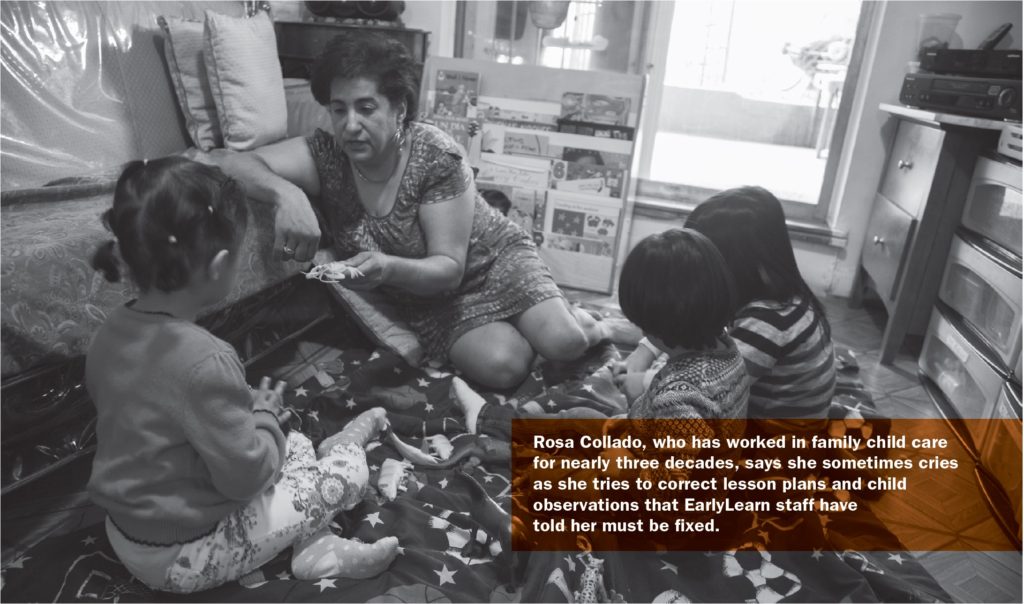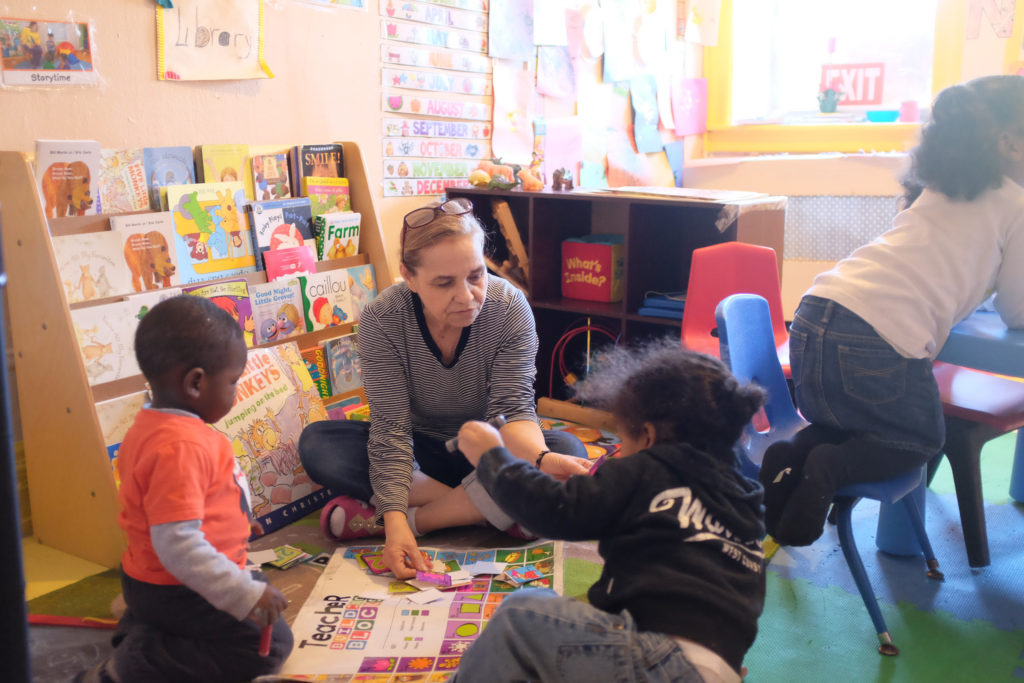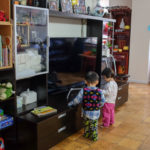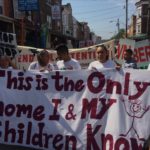
Family Child Care Provider Rosa Collado at her home in Bushwick. Photo: Ella Colley
In her section of the Bushwick neighborhood of Brooklyn, Rosa Collado is known as the lady who gets down on the floor with the small kids, chats with the bigger ones and has an endless supply of patience for their harried, overtaxed, working parents. For nearly three decades, she has provided child care to neighborhood Spanish-speaking kids. For the past two years, Collado has looked after them in her sparse, clean ground-floor apartment as part of EarlyLearn.
This article, the third in a series, was written by Kendra Hurley as part of the new report, Bringing it All Home: Problem’s and Possibilities facing NYC’s Family Child Care.
Becoming an EarlyLearn provider has its perks: Collado now has access to a steady stream of Spanish-speaking kids needing subsidized care—no longer an easy feat in an area where arty cafés and hipster bars have taken root as rents have risen. Collado has also learned a lot through trainings and home visits from the professional support staff at her EarlyLearn network. She now keeps toys in clear plastic bins low to the ground, where the kids can find them without her help. And she can explain how everyday tasks are infused with learning opportunities: that slicing a banana is a chance to talk about circles and the color yellow; that leaves in her backyard can be the spark for both an art and counting project.
But Collado is also painfully aware of all the ways in which she falls short as an EarlyLearn provider. Her living room is not large enough to set up the distinct “learning areas” prescribed by the Creative Curriculum that EarlyLearn providers must follow. And Collado cannot do the paperwork. She has spent many an evening crying as she tries to correct lesson plans and child observations that staff at New Life Child Development Center, the network organization that monitors her home, has said must be fixed.
New Life staff hold regular voluntary and unpaid night workshops to give providers more help. Collado, who makes only about $35,000 a year for looking after four toddlers full-time, has attended many, but still does not get it. New Life program director Sonia Vera has concluded that Collado simply is not capable of living up to EarlyLearn’s expectations. “She knows how to do her job but she doesn’t know how to put it in writing,” she says.
EarlyLearn’s family child care program has many women like Collado: women who are loving, warm, competent providers; who have a knack with babies and toddlers in particular; some of whom are fixtures in their communities, taking in generations of neighborhood kids. Yet they are also women who, for all practical purposes, fail as EarlyLearn providers because they cannot meet the reform’s requirements.
Today, more than three years into the reform, staff at a number of the networks say that this disconnect between what some family providers can actually do and what the city expects of them demonstrates an underlying problem with EarlyLearn. It is built around what’s known to improve quality in fully staffed child care centers with teachers who hold early education degrees; it does not take into account the realities and limitations of what many family child care providers are capable of, nor does it recognize and enhance what they do well.
“Now they expect the provider to have an area for sleeping, and an area for pretending, and an area for science. They want it to be a daycare 24/7,” says Vera. “And that doesn’t work in family daycare. Family daycare should be part of the family. It’s a home.”
MISMATCHED EXPECTATIONS
Under EarlyLearn, home-based providers are required to use a curriculum written in English, although many do not read English. And while a number of home providers lack high school degrees, they also are expected to enter child observations into a computer program and then analyze which educational objectives a child is and is not meeting.
Some network staff regard this mismatch between expectations and reality as evidence for what they consider a disregard for the city’s contracted family child care programs. With almost no prompting, they can rattle off a list of times when city workers charged with supporting home-based programs seemed to think they were working with centers instead. In the Bronx, an Administration for Children’s Services (ACS) worker charged with providing technical assistance to family child care networks told a home provider that she must take down posters with drawings of vegetables and replace them with photographs instead. She was referring to a quirky requirement regarding corporate posters in centers, but it left the home provider dumbfounded. “You can’t tell someone that they can’t have posters in their own home,” remembers Charmaine Swearing, EarlyLearn coordinator at Women’s Housing and Economic Development Corporation (WHEDco).
Then there was the call that Carmen Rivera of University Settlement received from ACS informing her that the 200 slots for children in her home-based programs were underenrolled and that University Settlement would be penalized for it. In fact, the program was not underenrolled—it simply had a lot of infants. Unlike classes in centers, family programs take in children of different ages, and when a program has a child younger than 2, state guidelines reduce the maximum number of children she can take in to make sure the baby gets adequate attention. “These people who were supposed to be our go-to people [at ACS] didn’t know that family child care was a weighted environment,” says Rivera. “I sometimes feel that ACS doesn’t remember that family child care exists.”
Under EarlyLearn, home-based providers are required to use a curriculum written in English, although many do not read English.
Laurie Samuel, former director of the family child care network at Lutheran Social Services, was surprised when she moved from Lutheran’s center-based program to its family child care network to see how little attention ACS provided the family child care branch. “I feel like they never knew what [their family child care programs] should look like,” remembers Samuel. “We were the stepchild to the centers.”
Imposing a center-based vision of quality onto home-based programs can be an exercise in disappointment, placing a sharp focus on all the ways that family child care can never measure up. Home-based programs typically have less space than centers do. With both toddlers as well as babies too young to walk in home-based care, trips outside are difficult. There’s no sharing of sand tables or art supplies or tricycles between classrooms; no gym for rainy days; no designated janitor, security guard, cook, teacher, assistant teacher or director. The provider must have it all and do it all, usually with very little money, working hours before and after the children arrive, and often in isolation.
The staff charged with monitoring these programs are themselves often isolated, spending the bulk of their weeks traveling from one provider to another. They sometimes feel marginalized within their own organizations and say that they aren’t given the same resources as the center-based programs. An organization’s mental health consultant, for instance, will typically work with families in the center-based program but not those in the home-based branch.
One head of a family child care network told us she was routinely asked to help with the center’s classrooms, but says that there’s no reciprocity. She got misty-eyed talking about the senior level meetings with ACS that did not include her, how her organization gave kids in center-based care presents at Christmas but not those in the home programs, and the internal organizational refrain she had heard throughout a career devoted almost exclusively to family child care: “‘You don’t bring in money. You cannot hire.’ [Nonprofit administrators] always remind me that they have to take money from other places for this.”
Now they expect the provider to have an area for sleeping, and an area for pretending, and an area for science. They want it to be a daycare 24/7,” says Vera. “And that doesn’t work in family daycare. Family daycare should be part of the family. It’s a home.”
As part of EarlyLearn, family child care networks must have a link to child care centers, so that young children can transition to the center programs when they hit preschool age—something that appears to be working well under EarlyLearn.
But it has come at a cost. Some stand-alone family child care networks with a passion and dedication for home-based care lost their contracts, while some child care centers with no experience working with home providers began overseeing family child care programs with potential enrollments of 200 kids or more.
“WE CAN NEVER COMPETE”
In interviews with the Center for New York City Affairs, staff at many such child care centers revealed a pervasive, underlying sense that the quality of care in even the best homes will inevitably be lower than that in good centers. One education director at an organization with both a child care center and a robust family child care program talked with pride about how the kids in their home programs were thriving. Her proof? At a graduation ritual that included children of the same age from both center and home programs, the kids from the home programs “did almost as well as the ones in the center.”
Some providers themselves share this view. “We can never compete with center-based care,” Mariainez Quinones of Hooting Owls in lower Manhattan child care says. “Most of us live in the projects. We can never compete.”
It is no wonder that the single family provider working alone is fast declining in EarlyLearn. When ACS first conceived EarlyLearn, they wanted no more than half of home-based programs to include those where the licensed provider hires assistant teachers to help. But such “group programs”—which often resemble a classroom in a child care center—have turned out to be better suited to weather EarlyLearn. Today, more than 80 percent of the children in the city’s EarlyLearn family child care programs are in group-based family child care, according to data from ACS.
The group programs can take in more young children than programs headed by single providers, bringing in more money while making for more efficient oversight by the networks—network staff can observe more children in each visit. With multiple teachers, group providers also have an easier time completing paperwork.
But Lisa McCabe, director of the Cornell Early Childhood Program, says that insisting that family child care programs live up to center-based standards not only sets them up for second-class status, it also sidesteps the opportunity to have a real conversation about what young children’s learning looks like, and how to support that across many different settings.
“We have to think long and hard about what do we mean by quality,” says McCabe. “Anytime we look at the early childhood education system, we always start with classrooms…. If you go in and measure [a home-based program] using an evaluation tool that looks at things like how many math manipulatives do you have, and how many times of the day do you spend on activities…center-like programs will always look better. That makes sense. But what is your actual goal for the kids? In school, people kind of expect a more formalized learning element. Should that be present in family child care? I have really mixed feelings about that.”
Collado may not be able to articulate what, exactly, her children are learning. But when Sonia Vera walks into Collado’s home, she sees mostly strengths. On one November morning, a warm breeze flows through an ajar patio door as Collado hovers above a small table and serves three shyly smiling children a stew of chicken, carrots and rice that she cooked at sunrise. Collado chatters with the kids animatedly as they giggle and play peek-a-boo across the table. While not siblings, they have that kind of ease among them. They clearly love spending time with each other, with Collado, and in Collado’s home. And as Vera watches, what she sees is three young children in what’s typically a child’s first learning environment—not a school, but a home. It is the increasing rarity of this that she wants to preserve.
As Vera watches, what she sees is three young children in what’s typically a child’s first learning environment—not a school, but a home. It is the increasing rarity of this that she wants to preserve.
So she has told Collado not to worry about creating learning centers in her home. Instead, she asked her to create just two areas—one where the children can be quiet and another where they can be loud and run around. And though Collado never completes her paperwork on time, or correctly, Vera made an executive decision. When she relayed it to her staff, the decision felt almost defiant, and Vera knew it would cost her staff time and money in the long haul, but she saw no ethical way around it.
“How are you going to tell Rosa to do something when you know she is not going to be able to do it?” Vera asks. “So I told the girls, ‘Let her do whatever she can do and we fix it. Let her spend more time with the children.’”
This article is part of a report, Bringing it All Home: Problem’s and Possibilities facing NYC’s Family Child Care, from the Center for New York City Affairs at The New School. The report focuses on home-based centers in the city’s EarlyLearn program.
Fi2W is supported by the David and Katherine Moore Family Foundation, the Ralph E. Odgen Foundation, an anonymous donor and readers like you.




